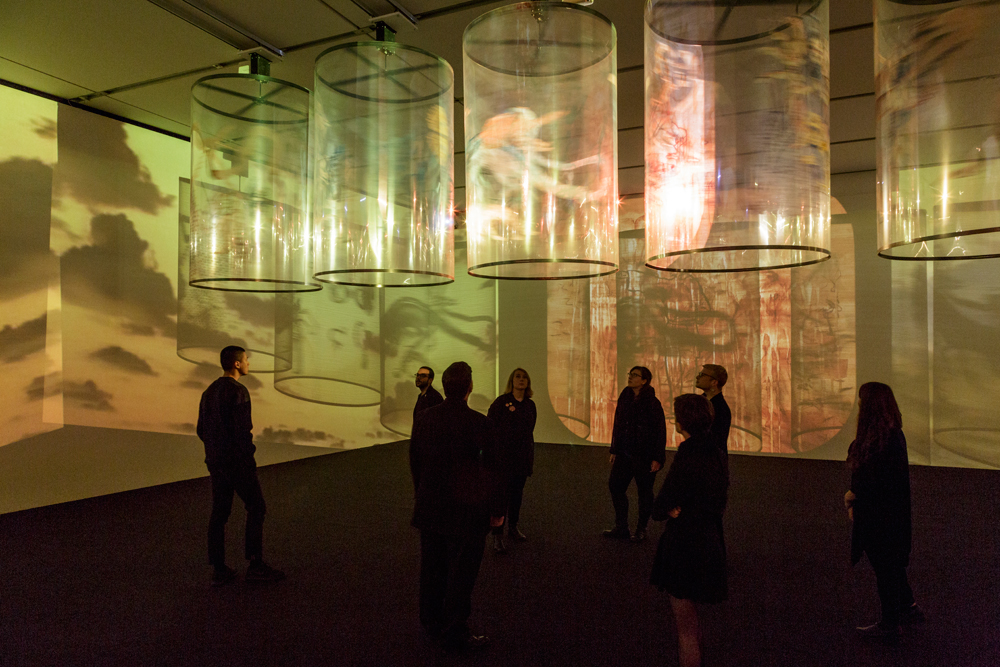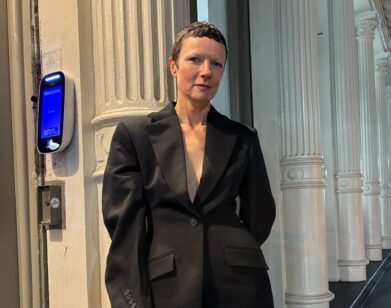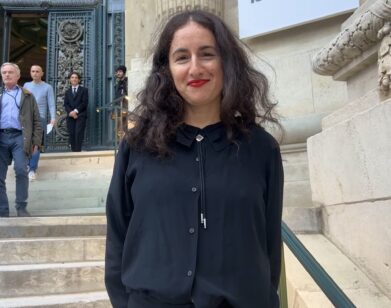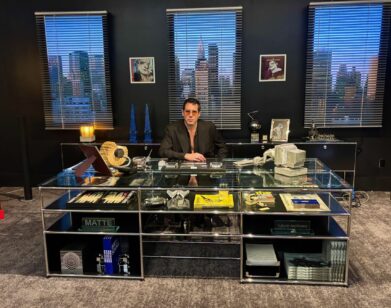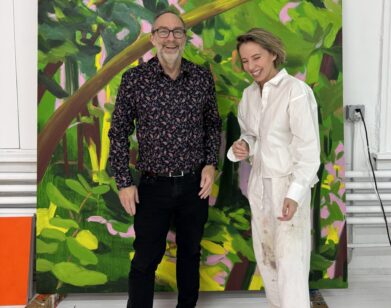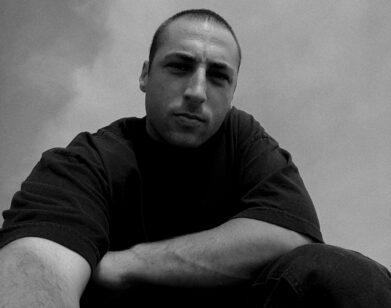Nalini Malani Tells a Story
Artist Nalini Malani’s exhortations to address violence are particularly poignant after this month’s tragedies. When we speak by phone, shortly before today’s opening of her exhibition at the ICA Boston, she emphasizes the artist’s responsibility to consistently evoke discourse about conflict. In her installation, In Search of Vanished Blood (which debuted at Documenta in 2012 and will be the core of her current show of the same name), mylar cylinders hang in the center of the gallery, rotating and projecting moving shadows onto the walls. The images derive from both Eastern and Western mythology, pointing toward universal themes of violence and the suppression of female voices—about the later of which Malani is more hopeful.
Throughout the past three decades, Malani has become one of India’s foremost advocates for women in the arts, actively contributing to progressive efforts as well as by making her own work. In 1985, she organized the first exhibition of female Indian artists in the country. Now 70 years old, Malani has gained worldwide acclaim for her large-scale installations, video art, and paintings. Drawing from universal texts, her work often unites elements of vastly different cultures, and in October 2017, the Centre Pompidou will present her retrospective, marking the institution’s first for an Indian artist.
We spoke to Malani about her artistic practice, influences, and future projects while she was installing her show in Boston.
ALINA COHEN: In this space, at this particular time, do you feel that In Search of Vanished Blood has any special resonance?
NALINI MALANI: The work has to do a lot with what we have been going through in India and other parts of the world. Somehow, in the world we live in today, violence has taken over in such a huge way that I feel that it needs to be addressed by artists and talked about all the time. The other thing that affects us enormously is the neglect of feminine thought. We have suffered too long in our civilization. It needs to be addressed in a big way. The work has to do with that, the feminine voice, the feminine thought, the idea [of what] femininity and masculinity are. A balance has to be created for things to really work in a creative way.
COHEN: I read that the work is inspired by Cassandra [of Greek mythology]. Do you identify with that character?
MALANI: Cassandra exists in all of us because the idea of prophecy or intuitional knowledge exists in all of us, only we have to hear it. The Cassandra idea is something that is around us and in us, but I think it’s very important that it has to be heard. There are so many things we know are harmful to the environment and the ecological systems, yet we pursue them even though they have noxious effects. That’s part of the Cassandra idea.
COHEN: When you made this work for Documenta, the world looked a little bit different. Do you think we’ve made progress? Feminist issues and violence—do you think they’ve gotten worse?
MALANI: I think they’ve gotten worse. It’s not looking good at all. It’s really a sad state of affairs at the moment. We should be in mourning.
COHEN: What about in terms of women in art?
MALANI: I think things are very fortunate. The woman’s voice, at least among the artists, is being brought forward and showcased by museums and galleries. My own gallery, Galerie Lelong, actually shows largely women artists. There are two artists who come to mind very strongly: Nancy Spero and Ana Mendieta. These two artists, for so long, never had a proper exhibition or a museum show. It’s only in the last few years that their work is being recognized for its importance. I hope that starts spreading. I think that’s going to make a difference, that women’s voices in the arts are being heard seriously.
COHEN: I wanted to ask about the mechanics of In Search of Vanished Blood. Where do the images and sound come from?
MALANI: I’ll give you a brief history of how I started to work in this format. It started in 1992-93 when there were huge sectarian riots in my city, in Bombay, and many people lost their lives. The rise of Hindu fundamentalism led to the riots. I wanted to create images from the Hindu epics, which are not at all moralistic, but more open-ended. This, I think, is the prerogative of the artist, to bring forth ancient myths into the contemporary fold, to make them alive again—just like Cassandra, or Medea, which I’ve been using. Among the Hindu myths I wanted to do the same. I wanted to make immersive spaces where visitors could walk in and get completely encompassed with my images and the video and the shadows. That’s how it started.
I wanted to make Buddhist prayer wheels as a mark of peace. In this particular case, In Search of Vanished Blood, the title of the piece comes from a revolutionary poet from Pakistan, Faiz Ahmed Faiz, who talks about blood vessels being shed, but who has died? Who has been the killer? And where is this blood? It’s almost like lives are being lost in this useless way and nobody’s claiming that they are the murderers. Who are the murderers? Who are the conquerors at fault, and so on? This is one aspect of it.
Then, Cassandra is an overarching idea that has persisted through many works. It’s what I call female thought and that has helped me work through ideas regarding violence. Not only violence of one person perpetuating it on another, but also violence against our environment and nature, and also particularly as we have it in the South Asian part of the world, where there’s a huge amount of violence perpetuated on women through rape on young girls and rape on tribal communities. All of this is reflected in the shadow plays.
Now about the images, I choose images from mythic stories. They are my own style, but also melding a certain kind of painting called Kalighat style, which was the beginning of modernism in India. I hold on to that flag called modernism; one can have criticism about modernism, but modernism brought out respect for the individual. This, I think, is something that we need to come back to today, because the identities of individuation are getting lost within ideas of religion. Religion has played important roles in the past, no doubt, but it’s a very private affair. I think the way it’s being bandied about, as if one god is better than the other, is against the real idea of spirituality, of religion. These are huge topics and they don’t just get confined to one artwork. They go through many of my works.
The sound I composed myself. I hate to use the word “composed.” It’s more like designed—I use my own voice for the text and also for the singing voice, I sing.
COHEN: How do the images match up with the audio? Is there a narrative formed?
MALANI: It’s actually a montage of different texts. In this particular piece, I have a piece from Samuel Beckett, a piece from Faiz. The Faiz poem is not spoken. The poem scrolls over the face; it appears as words on a veiled face, which refers to waterboarding. Then I have things from the Indian writer Mahasweta Devi, who has been writing about the tribal communities. Heiner Müller is one playwright who I find very inspiring, so it’s very theatrical. The voice also becomes quite theatrical.
It’s also about communication. I use Morse code and in the images themselves I also use hand sign language. It’s like trying to get out there and communicate with every form possible to say “listen, because we have to hear what’s happening.” Put your ear to the ground. Are the earthworms still there, or are we killing them? Just like technology has given us so much, but we also know that the radio waves are killing the bees. Bees can’t go back to the fields and to their hives because they get lost in this mesh of waves. So there’s the underside to everything that we have invented. We have to pay attention to that because we have to know the balance. We have these wonderful things—look at the cars we have, look at the sailboats. We have everything, so what is the malaise that leads to this violence?
COHEN: What do you think it is?
MALANI: I don’t have the answers. I wish I did, but I don’t. I can only see the symptoms. I can see it and I can talk about it as an artist. I can try to find a form that might convey it, but to understand that type of violence, which is raw violence, in spite of having everything—what is it? It’s worth thinking about and trying to find an anodyne that might somehow reduce that rage. Art itself in its very innateness is humanistic and hence never aggressive. In that sense I feel art, if people are willing to listen, can [reduce rage], but it needs participation.
I always believe that art has a three-bodied relationship: there’s the artist, the artwork, and the viewer. Together, we wake up the art. It’s only together that we say, “This is alive.” Otherwise, art sleeps.
COHEN: Do you see using your own voice within the exhibition as one more way that you can make your voice heard?
MALANI: With my voice, I don’t use it in the pure form. I manipulate the voice digitally, so when you hear it, it may sometimes sound like a child’s voice, sometimes like a masculine voice. It’s not so much that I’m interested for people to know that this is my voice. I tried using other people’s voices but I find I’m not able to get the right pitch. Because I know exactly what I want, it’s best I try it myself; it’s not so much that my voice should be heard. I’m not even speaking words that are my own because I think other people have written things which are much more integrated in terms of language and poetry. I prefer someone else’s poetry and appreciate it more. In this theatrical setting, it’s possible to collaborate with other poets and artists. I am very interested in collaboration and I have done quite a bit in the past. I consider this to be kind of collaborative with the works of Faiz, Beckett, and Mahasweta Devi.
COHEN: You collaborate with people from so many different areas. Are there any writers or playwrights or people in film who you’re particularly interested in right now?
MALANI: Heiner Müller is an ongoing interest. What he has done is a real breakthrough in theater. He comes from East Berlin, and you would wonder why I, from India, would be interested in something that comes from East Berlin. But in the ’80s, India was aligned to the Eastern Bloc, so we had a lot of literature that came in from East Berlin, including Bertold Brecht and Heiner Müller and Christa Wolf. These were people we were reading at that time. Heiner Müller is somebody who combines Brecht and a classical, almost Shakespearean language. He combines the classical with the graffiti, which is interests me. It’s fusing high language with scratch of the street. I like the melding of the two.
COHEN: Can you tell me what you are working on now?
MALANI: It’s a very ambitious project. I’m not sure if I’m going to fall flat on my face, but I’ll tell you about it. In South Asia, in the period before the British colonized India, the only women who were allowed to pursue the arts were the courtesans. Once the British came in, they called them whores and had brothels and so on. But the word “courtesan” was a very high-class word and they were very high-class ladies. Today we have feminine music from the 13th and 14th centuries and this music has come to us because the British left it well alone. They couldn’t follow what it was about, so they didn’t mess with it, as they did with the visual arts. This music turned out to be a very powerful kind of art and it’s getting usurped by the male voice, by male singers. It’s poetry put to music, so it is in the feminine gender, but it’s men singing in the feminine gender, which is very interesting. So I want to make an artwork about this. It’s going to be complex. I’m working with very fine musicians who are women who have been teaching me about the form. I hope to show this next year when I have my retrospective at the Centre Pompidou.
“IN SEARCH OF VANISHED BLOOD” OPENS TOMORROW AT THE ICA BOSTON.

